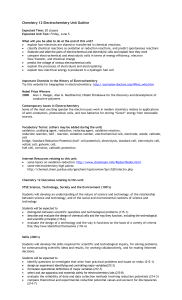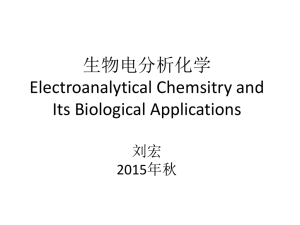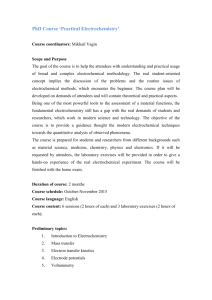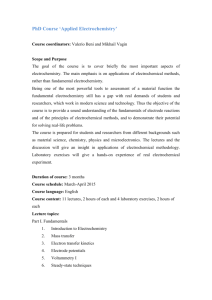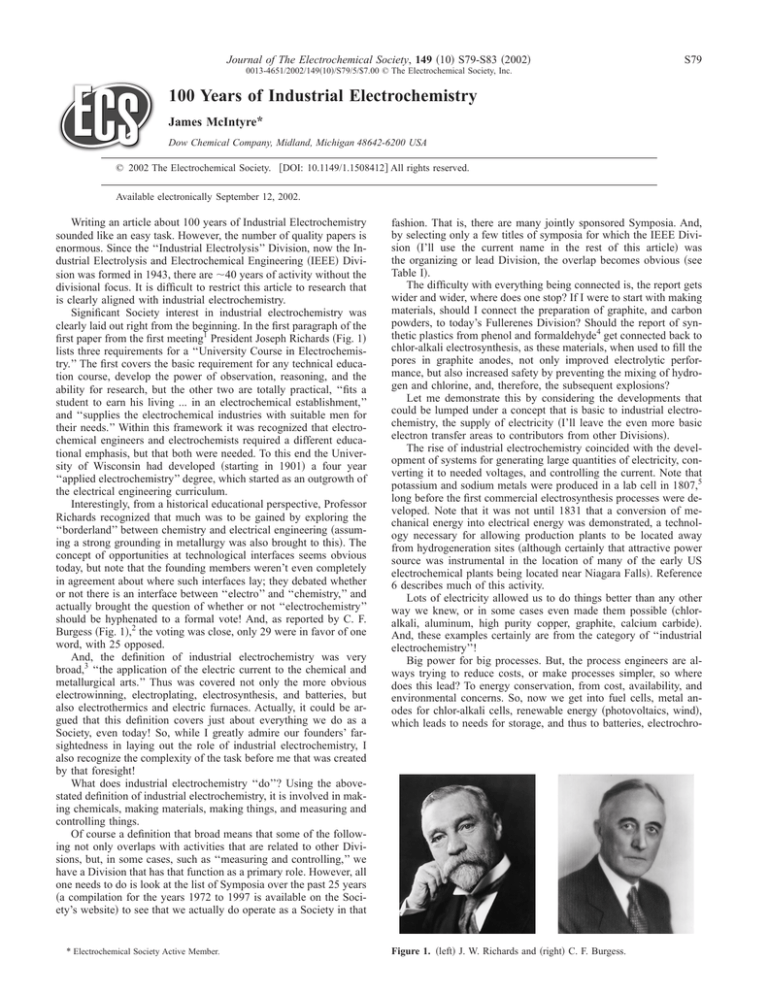
Journal of The Electrochemical Society, 149 共10兲 S79-S83 共2002兲
S79
0013-4651/2002/149共10兲/S79/5/$7.00 © The Electrochemical Society, Inc.
100 Years of Industrial Electrochemistry
James McIntyre*
Dow Chemical Company, Midland, Michigan 48642-6200 USA
© 2002 The Electrochemical Society. 关DOI: 10.1149/1.1508412兴 All rights reserved.
Available electronically September 12, 2002.
Writing an article about 100 years of Industrial Electrochemistry
sounded like an easy task. However, the number of quality papers is
enormous. Since the ‘‘Industrial Electrolysis’’ Division, now the Industrial Electrolysis and Electrochemical Engineering 共IEEE兲 Division was formed in 1943, there are ⬃40 years of activity without the
divisional focus. It is difficult to restrict this article to research that
is clearly aligned with industrial electrochemistry.
Significant Society interest in industrial electrochemistry was
clearly laid out right from the beginning. In the first paragraph of the
first paper from the first meeting1 President Joseph Richards 共Fig. 1兲
lists three requirements for a ‘‘University Course in Electrochemistry.’’ The first covers the basic requirement for any technical education course, develop the power of observation, reasoning, and the
ability for research, but the other two are totally practical, ‘‘fits a
student to earn his living ... in an electrochemical establishment,’’
and ‘‘supplies the electrochemical industries with suitable men for
their needs.’’ Within this framework it was recognized that electrochemical engineers and electrochemists required a different educational emphasis, but that both were needed. To this end the University of Wisconsin had developed 共starting in 1901兲 a four year
‘‘applied electrochemistry’’ degree, which started as an outgrowth of
the electrical engineering curriculum.
Interestingly, from a historical educational perspective, Professor
Richards recognized that much was to be gained by exploring the
‘‘borderland’’ between chemistry and electrical engineering 共assuming a strong grounding in metallurgy was also brought to this兲. The
concept of opportunities at technological interfaces seems obvious
today, but note that the founding members weren’t even completely
in agreement about where such interfaces lay; they debated whether
or not there is an interface between ‘‘electro’’ and ‘‘chemistry,’’ and
actually brought the question of whether or not ‘‘electrochemistry’’
should be hyphenated to a formal vote! And, as reported by C. F.
Burgess 共Fig. 1兲,2 the voting was close, only 29 were in favor of one
word, with 25 opposed.
And, the definition of industrial electrochemistry was very
broad,3 ‘‘the application of the electric current to the chemical and
metallurgical arts.’’ Thus was covered not only the more obvious
electrowinning, electroplating, electrosynthesis, and batteries, but
also electrothermics and electric furnaces. Actually, it could be argued that this definition covers just about everything we do as a
Society, even today! So, while I greatly admire our founders’ farsightedness in laying out the role of industrial electrochemistry, I
also recognize the complexity of the task before me that was created
by that foresight!
What does industrial electrochemistry ‘‘do’’? Using the abovestated definition of industrial electrochemistry, it is involved in making chemicals, making materials, making things, and measuring and
controlling things.
Of course a definition that broad means that some of the following not only overlaps with activities that are related to other Divisions, but, in some cases, such as ‘‘measuring and controlling,’’ we
have a Division that has that function as a primary role. However, all
one needs to do is look at the list of Symposia over the past 25 years
共a compilation for the years 1972 to 1997 is available on the Society’s website兲 to see that we actually do operate as a Society in that
* Electrochemical Society Active Member.
fashion. That is, there are many jointly sponsored Symposia. And,
by selecting only a few titles of symposia for which the IEEE Division 共I’ll use the current name in the rest of this article兲 was
the organizing or lead Division, the overlap becomes obvious 共see
Table I兲.
The difficulty with everything being connected is, the report gets
wider and wider, where does one stop? If I were to start with making
materials, should I connect the preparation of graphite, and carbon
powders, to today’s Fullerenes Division? Should the report of synthetic plastics from phenol and formaldehyde4 get connected back to
chlor-alkali electrosynthesis, as these materials, when used to fill the
pores in graphite anodes, not only improved electrolytic performance, but also increased safety by preventing the mixing of hydrogen and chlorine, and, therefore, the subsequent explosions?
Let me demonstrate this by considering the developments that
could be lumped under a concept that is basic to industrial electrochemistry, the supply of electricity 共I’ll leave the even more basic
electron transfer areas to contributors from other Divisions兲.
The rise of industrial electrochemistry coincided with the development of systems for generating large quantities of electricity, converting it to needed voltages, and controlling the current. Note that
potassium and sodium metals were produced in a lab cell in 1807,5
long before the first commercial electrosynthesis processes were developed. Note that it was not until 1831 that a conversion of mechanical energy into electrical energy was demonstrated, a technology necessary for allowing production plants to be located away
from hydrogeneration sites 共although certainly that attractive power
source was instrumental in the location of many of the early US
electrochemical plants being located near Niagara Falls兲. Reference
6 describes much of this activity.
Lots of electricity allowed us to do things better than any other
way we knew, or in some cases even made them possible 共chloralkali, aluminum, high purity copper, graphite, calcium carbide兲.
And, these examples certainly are from the category of ‘‘industrial
electrochemistry’’!
Big power for big processes. But, the process engineers are always trying to reduce costs, or make processes simpler, so where
does this lead? To energy conservation, from cost, availability, and
environmental concerns. So, now we get into fuel cells, metal anodes for chlor-alkali cells, renewable energy 共photovoltaics, wind兲,
which leads to needs for storage, and thus to batteries, electrochro-
Figure 1. 共left兲 J. W. Richards and 共right兲 C. F. Burgess.
S80
Journal of The Electrochemical Society, 149 共10兲 S79-S83 共2002兲
Table I. Division symposia subjects which overlap with the activities of other Divisions.
Symposium title
Automated Control of Industrial Processes
Electrowinning and Electrorefining of Metals
Salt Electrolytes
Fuel Cells
Electrolytic Diaphragms and Battery Separators
Energy Conversion and Storage in Biological Systems
Energy Conservation in the Electrochemical Industries
Organic Luminescence
Electrodeposition of Paint
Sensing, Control, and Treatment for Pollution Prevention
Year
1943
1952
1957
1961
1965
1979
1981
1985
1991
1997
Figure 3. 共left兲 R. Hunter and 共right兲 H. Beer.
mics for better solar shielding, etc. So, even this path leads from
IEEE into other Divisions. But, it does show the underlying influence of ‘‘industrial electrochemistry.’’
Perhaps a better approach is to consider what activities may be
considered to be closely or exclusively related to industrial electrochemistry or the IEEE Division. Two are readily apparent, the Report of the Electrolytic Industries, a unique summary of ‘‘published
information on production, plant capacities, consumption, demand,
trends, prices, raw materials, new technology, and environmental
issues in the electrolytic and related industries,’’ and for continuing
to make a change from Professor Richards describing our activities
as ‘‘arts,’’ to activities that are much more based in science, the
development of a quantitative understanding of all factors important
to the engineering of electrochemical processes 共originally in the
Theoretical Division兲.
Certainly changes in how we do industrial research and development have occurred over the past 100 years, and the Journal’s contents record those changes. Because electrolytic chlor-alkali production is such an important part of industrial electrochemistry, because
its history is only slightly older than the Society’s 共first commercial
plant in US at Rumford Falls, Maine, 1893兲, and because some of
the Society’s great names 共Hooker, Dow, DeNora, Beer, Sperry,
Townsend, Acheson, L. H. Baekland 共Fig. 2兲, Tobias, Newman 共and
I apologize to many others not included here兲兲 were involved either
directly or indirectly with chlor-alkali, I will use some examples
from this industry to show those changes. Note this is not intended
to be a complete history, a few papers will be noted that illustrate the
changes.
If we exclude Acker’s cell7 that electrolyzed molten sodium
chloride for the production of caustic 共not sodium!兲 and chlorine,
there are three main types of cells that have been used for chloralkali production, diaphragm, mercury, and membrane. All three
have positive and negative features that have influenced their utilization. Mercury cells produce a salt-free caustic solution, and do not
require steam for evaporation of the caustic to the 共common兲 50%
solution of commerce 共making hydropower an effective energy
source for these cells兲. However, they do require a source of solid
Figure 2. 共left兲 L. H. Baekland and 共right兲 H. H. Dow.
salt, and great care must be exercised during operation to avoid
mercury losses with subsequent negative environmental impact.
Diaphragm cells can use solution-mined salt, thus extending their
economically viable locations, and if the salt-containing caustic solutions can be used for subsequent chemical processing, the overall
production costs can be very low. However, if caustic is to be produced for sale, steam for evaporation is required, thus favoring locations where fossil fuels are relatively inexpensive. And, historically, the best diaphragms have consisted entirely of, or at least have
contained significant amounts of, asbestos, with the attendant environmental concerns. Ion exchange membrane cells produce pure
caustic, while operating at relatively high current densities. But they
require solid salt that is virtually free of divalent cations. This is not
to imply that the other cells are greatly impurity-tolerant 共see, for
example, an early study which warned against iron contamination in
mercury cells8兲, just that each cell brings its own operating discipline requirements.
The reader is referred to Vorce’s excellent summary9 of US
chlor-alkali cell development up to 1944. He notes that the first
commercial cell in the US was E. A. LeSueur’s.10 Another notable
cell was designed by Townsend and Sperry 共E. A. Sperry, of gyroscope fame, who was also a Founding Member!兲. It is interesting to
note that in Townsend’s presentation to the Society,11 Sperry is not
acknowledged. But it required funding from E. H. Hooker’s Development and Funding Company to build a commercial-scale version.
Obviously this was a successful relationship.
Unfortunately for the historical record, in spite of the commercial
success the Dow cells were enjoying, the company chose to keep
their technology in house 共but by 1952 a good deal was known,12
presumably via the patent literature兲. Note that this did not reflect a
negative attitude toward the Society, H. H. Dow 共Fig. 2兲 was a
founding member who presented a paper13 at the first meeting, but it
was on zinc-bromine batteries, not chlor-alkali. And, as noted in the
Presidential address given by Ralph Hunter 共Fig. 3兲 in 1952,14 Dow
encouraged attendance at Society meetings, and personally had
regular contacts with other Society members, even claiming that ‘‘he
and Acheson’’ had concluded that fine grinding was of great merit in
preparing graphite for anodes.
While Europe had an early lead in the development of mercury
cells, an early example of a commercially operated, US-developed
cell was that of Whiting.15
There followed a long period of improvements in the general
design of these two types of cells, including the use of different
materials of construction and modified operating procedures that led
to higher efficiencies. While not intending to minimize these contributions, many were ‘‘normal’’ process improvements. Cell bodies
went from tarred wood, to concrete, steel, polymer composites, and
finally titanium. Anodes moved from carbon to graphite to coated
titanium. Cathodes have shown probably the least change, as steel
was an original choice and is still used today, although frequently it
is coated to reduce the hydrogen overvoltage 共see further兲. Porous
separators have also shown less dramatic changes, having started
Journal of The Electrochemical Society, 149 共10兲 S79-S83 共2002兲
with asbestos, which is still used today, although asbestos composites that offer some improvements have been developed. Nonasbestos diaphragms comprised of polytetrafluoroethylene and zirconium
oxide particles have also been commercialized.
For mercury cells Gardiner notes16 that companies such as OlinMathieson, Solvay, de Nora, Hoechst-Uhde, Krebs-BASF, and others took advantage of the improvement of silicon rectifiers over
mercury arc rectifiers to develop larger, more efficient cells that
incorporated improved anode designs, adjustable anodes, liners that
allowed higher temperature operation, etc.
In the diaphragm cell arena, one new procedure was to have
great impact, Stuart’s development of drawn asbestos diaphragms,
as opposed to the earlier use of paper or cloth. This method allowed
much greater flexibility in cell design, as diaphragms could be deposited on cathodes of any shape. This procedure became the industry standard. Note that even as composite asbestos diaphragms were
developed by, for example, Diamond Shamrock, Hooker, and PPG,
the concept of drawing the diaphragm remained dominant.
And so the industry continued to grow, with constant small improvements in performance which, as argued by Gomory,17 is the
way technology normally develops.
But then Henri Beer 共Fig. 3兲 discovered one of the holy grails of
chlor-alkali technology, that of the use of ruthenium oxides on titanium as a nonwearing anode, which became known as dimensionally stable anodes™. Gone was the need for adjusting the anodecathode spacing in mercury cells, gone was the increased power
consumption with time in diaphragm cells as the graphite wore
away, increasing the anode-cathode spacing, and gone was one impediment to the use of the new oxidatively stable polymeric ion
exchange membranes, the potential for fouling due to the impurities
produced as a consequence of this wear.
As these anodes were developed, two other features brought improvements to the industry; they allowed the use of higher current
densities which in turn increased production per cell, and they lowered the chlorine overvoltage, which reduced the cell energy consumption, and decreased the amount of oxygen contamination in the
chlorine.
It is important to note that this superb invention was just that, an
invention. Beer did not have the resources to fully commercialize
his discovery. But, thanks to the efforts of Oronzio and Vittorio de
Nora, including the relationship with Diamond Shamrock, this invention and its relatives have become the only choice for chloralkali anodes.
The other development that has made a huge impact is the application of ion exchange membranes. The first such membrane, a
perfluorosulfonic acid polymer, was developed by DuPont, originally for use in a NASA fuel cell project. The features of this material included a unique internal structure that allowed for high current densities with relatively low resistive losses and created a
surprisingly strong barrier to hydroxyl ion back-migration into the
anode compartment, while being stable to attack from both hot
acidic chlorine solutions, and hot concentrated sodium hydroxide.
Further developments by DuPont and by companies such as Asahi
Glass, Asahi Chemical 共now Asahi Kasei兲, and Tokuyama Soda have
given us materials that perform at even lower resistance at very high
current densities, and offering even better hydroxyl ion rejection,
which, combined with new cell technologies 共for example, DeNora,
Asahi Kasei, Asahi Glass, Chlorine Engineers, ICI, Lurgi, Oxytech,
Hoechst-Uhde兲 have made ion exchange cells economically competitive with diaphragm and mercury cells.
But, as suggested by Vorce,9 many of the successful developments were based on the inventor’s knowledge of working cells,
which they then used to make changes to fix some operating problem. He notes it took ‘‘horse sense’’ combined with a few fundamental points to handle these cells. But, the fundamental points were
not well understood, or even agreed upon. In the early years there
were many presentations on what ionic dissociation really meant,
what porous diaphragms actually did in a cell, how to determine
current efficiency, etc.
S81
Figure 4. C. W. Tobias.
This should not be surprising, giving the difficulties of making
fundamental measurements under the conditions present in operating cells. Also, there was little help in using quantitative principles
to guide design, or even to help understand and model the important
variables in operating these cells, in order to make educated
changes, as prior to the efforts of Charles Tobias 共Fig. 4兲 in the early
1950s there was no ‘‘electrochemical engineering’’ as we know it
today. An informative account of the early development is given by
Tobias himself.18
An early Tobias publication on the effect of electrode resistance
on current density distribution in electrolytic cells19 had application
for determining the optimum size of the then universal, in diaphragm cells, graphite anodes. He also contributed much to our
understanding of the impact of bubbles on current distribution and
cell voltage.20,21 His use of solid spheres whose geometry was wellknown as a simulation of bubbles was very ingenious.22
Ralph White 共Fig. 5兲, a ‘‘Tobias grandchild,’’ became very active
in applying electrochemical engineering principles specifically to
chlor-alkali cells, in publications ranging from modeling current
distribution,23,24 to diaphragms,25 ion exchange membranes,26 and
even complete electrolyzers.27,28
The Tobias generational legacy in chlor-alkali continued with
some of John Van Zee’s work.29,30
As noted above, DuPont’s Nafion™, as described by Grot,31 was
the breakthrough material for use as ion exchange membranes, but
many other Society members contributed to our understanding
of how these materials work, and therefore how best to develop
them. These studies ranged from the theoretical32,33 to the
experimental.34-36
Of particular note is the work of Howard Yeager and his
associates,37-43 in their focusing on how the molecular structure of
both perfluorinated carboxylate and sulfonate ion exchange poly-
S82
Journal of The Electrochemical Society, 149 共10兲 S79-S83 共2002兲
Figure 5. R. E. White.
mers influenced their transport properties under concentration, current, and temperature conditions resembling those in a commercial
chlor-alkali cells.
The implementation of ion exchange membrane cells also made
another contribution to cell operational efficiency, the application of
catalytically-coated cathodes that reduced the overvoltage for hydrogen evolution.44-48 There are two basic types of ‘‘LOCs,’’ high surface area and catalytic. The catalytic coatings tended to be poisoned
under the operating conditions of diaphragm cells; the ‘‘cleaner’’
membrane cells don’t create this problem. Additionally, coatings
that withstand cell upsets which often result in current reversal have
been developed.
The original dimensionally stable anodes were indeed a breakthrough, but there still was a gap in our understanding of how
they worked. The Journal records many contributions49-53 to this
understanding 共which reference is not to slight the tremendous
amount of ‘‘understanding’’ that was being developed as proprietary information兲.
And while the methods and equipment available to these authors
for their studies had been much developed over the years, the Journal does record that much earlier authors were pursuing equivalent
understanding of the technology of their time, such as Johnson’s
study54 of the influence of cell operating conditions on graphite
anode wear rate, an important issue of that time.
Other industrial electrolytic processes followed similar development paths, from the early sometimes intuitive changes, through
early measurements of operating parameters that allowed extrapolations to new design modifications, or other sets of operating conditions, through much more detailed understanding, which developed
as new experimental and theoretical tools became available. The
Journal has faithfully recorded these changes, for 100 years.
Finally, it can be argued that without the influence of the industrial electrochemical members we would no longer exist as an independent society. That may appear to be a strong statement, but consider the following, taken from Volume XI of the Transactions 共from
the May, 1907, Philadelphia meeting兲. A proposal had been made to
publish our Society’s technical papers jointly with the American
Chemical Society, by combining the Transactions with the Journal
of Physical Chemistry. As a cost-cutting operation this had many
attractions. But it was noted that, since a primary reason for membership in either society was to obtain the meeting proceedings,
people who currently belonged to both societies would probably quit
one, and, it was expected that the Electrochemical Society would
absorb almost all of the loss, which was projected to be as large as
one-third of our membership. While the Board appeared to be
strongly in favor of entering into such a relationship, they did open
the idea to discussion. During that discussion it was noted 共Professor
C. F. Burgess兲 that 70-80% of the Society membership was from
industry, and that these members would be opposed to being absorbed into another society. So, it was agreed that the issue should
be decided via a mail vote by the whole membership.
Interestingly, the published discussions at subsequent meetings
make no mention of the results of the vote. However, it is clear that
we did not enter into this arrangement. Presumably Professor Bur-
gess was correct, the industrial members wanted to keep the Electrochemical Society as an independent organization. So perhaps we
can thank the early influence of ‘‘industrial electrochemistry’’ in
keeping our Society alive!
We have enjoyed the past 100 years. What of the future? After
reading Paul Kohl’s ‘‘One Hundred Years’’ editorial,55 and realizing
what has happened during the past 100 years, I don’t want to even
try to predict. I’ll leave the predictions to those made by BrucknerLea et al.,56 who quoted the noted philosopher and futurist L. P.
Berra, who said ‘‘Prediction is very hard, especially when it’s about
the future.’’
But, Mr. Berra also noted that ‘‘You got to be very careful if you
don’t know where you’re going, because you might not get there.’’
Thankfully we can use the information our Journal supplies to help
us decide where we want to go.
References
1.
2.
3.
4.
5.
6.
7.
8.
9.
10.
11.
12.
13.
14.
15.
16.
17.
18.
19.
20.
21.
22.
23.
24.
25.
26.
27.
28.
29.
30.
31.
32.
33.
34.
35.
36.
37.
38.
39.
40.
41.
J. W. Richards, Trans. Am. Electrochem. Soc., 1, 46 共1902兲.
C. F. Burgess, Trans. Electrochem. Soc., 82, 16 共1942兲.
J. W. Richards, Trans. Am. Electrochem. Soc., 1, 42 共1902兲.
L. H. Baekland, Trans. Am. Electrochem. Soc., 15, 593 共1909兲.
J. J. Leddy, in Electrochemistry, Past and Present, J. T. Stock and M. V. Orna,
Editors, American Chemical Society, Washington, DC 共1989兲.
R. B. MacMullin and W. C. Gardiner, Trans. Electrochem. Soc., 86, 51 共1944兲.
C. E. Acker, Trans. Am. Electrochem. Soc., 1, 165 共1902兲.
J. W. Walker and C. S. Paterson, Trans. Am. Electrochem. Soc., 3, 185 共1903兲.
L. D. Vorce, Trans. Electrochem. Soc., 86, 69 共1944兲.
E. A. LeSueur, Trans. Electrochem. Soc., 63, 187 共1933兲.
C. P. Townsend, Trans. Electrochem. Soc., 7, 63 共1905兲.
D. O. Hubbard, J. Electrochem. Soc., 99, 307C 共1952兲.
H. H. Dow, Trans. Am. Electrochem. Soc., 1, 127 共1902兲.
R. M. Hunter, J. Electrochem. Soc., 99, 155C 共1952兲.
J. Whiting, Trans. Am. Electrochem. Soc., 17, 327 共1910兲.
W. C. Gardiner, J. Electrochem. Soc., 125, 22C 共1978兲.
R. E. Gomory, Science, 220, 576 共1983兲.
C. W. Tobias, Electrochem. Soc. Interface, 3, 17 共1994兲.
C. W. Tobias and R. J. Wijsman, J. Electrochem. Soc., 100, 459 共1953兲.
J. Dukovic and C. W. Tobias, J. Electrochem. Soc., 134, 331 共1987兲.
D. P. Sutija and C. W. Tobias, J. Electrochem. Soc., 141, 2599 共1994兲.
P. J. Sides and C. W. Tobias, J. Electrochem. Soc., 129, 2715 共1982兲.
R. E. White, C. W. Walton, H. S. Burney, and R. N. Beaver, J. Electrochem. Soc.,
133, 485 共1986兲.
R. E. White, F. Jagush, and H. S. Burney, J. Electrochem. Soc., 137, 1846 共1990兲.
D. L. Caldwell, K. A. Poush, J. W. Van Zee, and R. E. White, in Electrochemical
Process and Plant Design, R. C. Alkire, T. R. Beck, and R. D. Varjian, Editors, PV
83-6, p. 216, The Electrochemical Society Proceedings Series, Pennington, NJ
共1983兲.
G. Pillay, D. L. Caldwell, and R. E. White, in Chlor-Alkali and Chlorate Production and New Mathematical and Computational Methods in Electrochemical Engineering, T. C. Jeffery, J. Fenton, K. Ota, and H. Kawamoto, Editors, PV 93-14, p.
85, The Electrochemical Society Proceedings Series, Pennington, NJ 共1993兲.
J. W. Van Zee, R. E. White, and A. T. Watson, J. Electrochem. Soc., 133, 501
共1986兲.
J. W. Van Zee and R. E. White, J. Electrochem. Soc., 133, 50 共1986兲.
P. C. Y. Chin and J. W. Van Zee, in Modeling and Simulation of Electrolytic
Solution Processes, D.-T. Chin and P. N. Pintauro, Editors, PV 88-18, p. 199, The
Electrochemical Society Proceedings Series, Pennington, NJ 共1988兲.
S. A. McCluney and J. W. Van Zee, J. Electrochem. Soc., 136, 2556 共1989兲.
W. G. F. Grot, in Diaphragms, Separators, and Ion-Exchange Membranes, J. W.
Van Zee, R. E. White, K. Kinoshita, and H. S. Burney, Editors, PV 86-13, p. 1, The
Electrochemical Society Proceedings Series, Pennington, NJ 共1986兲.
S. W. Capeci, P. N. Pintauro, and D. N. Bennion, J. Electrochem. Soc., 136, 2876
共1989兲.
P. N. Pintauro and Y. Yang, in Fundamentals of Electrochemical Process Design: A
Tutorial and Anodic Processes: Fundamental and Applied Aspects, J. B. Talbot, J.
M. Fenton, B. E. Conway, B. V. Tilak, Editors, PV 95-11, p. 266, The Electrochemical Society Proceedings Series, Pennington, NJ 共1995兲.
D. N. Bennion, in Membranes and Ionic and Electronic Conducting Polymer, E. B.
Yeager, B. Schumm Jr., K. Mauritz, K. Abbey, D. Blankenship, and J. Akridge,
Editors, PV 83-3, p. 78, The Electrochemical Society Proceedings Series, Pennington, NJ 共1983兲.
T. F. Fuller and J. Newman, J. Electrochem. Soc., 139, 1332 共1992兲.
B. V. Tilak and S. R. Fitzgerald, in Electrochemical Engineering in the ChlorAlkali and Chlorate Industries, F. Hine, W. B. Darlington, R. E. White, and R. D.
Varjian, Editors, PV 88-2, p. 247, The Electrochemical Society Proceedings Series,
Pennington, NJ 共1988兲.
H. L Yeager, B. Kipling, and R. L. Dotson, J. Electrochem. Soc., 127, 303 共1980兲.
H. L. Yeager and A. Steck, J. Electrochem. Soc., 128, 1880 共1981兲.
H. L. Yeager, B. O’Dell, and Z. Twardowski, J. Electrochem. Soc., 129, 85 共1982兲.
H. L. Yeager, Z. Twardowski, and L. M. Clarke, J. Electrochem. Soc., 129, 324
共1982兲.
Z. Twardowski, H. L. Yeager, and B. O’Dell, J. Electrochem. Soc., 129, 328 共1982兲.
Journal of The Electrochemical Society, 149 共10兲 S79-S83 共2002兲
42. H. L. Yeager and J. D. Malinsky, in Advances in the Chlor-Alkali and Chlorate
Industry, M. M. Silver and E. M. Spore, Editors, PV 84-11, p. 93, The Electrochemical Society Proceedings Series, Pennington, NJ 共1984兲.
43. A. A. Gronowski and H. L. Yeager, J. Electrochem. Soc., 138, 2690 共1991兲.
44. A. Nidola and R. Schira, J. Electrochem. Soc., 133, 1653 共1986兲.
45. E. Endoh, in Advances in Mathematical Modeling and Simulation of Electrochemical Processes and Oxygen Depolarized Cathodes and Activated Cathodes for
Chlor-Alkali and Chlorate Processes, J. W. Van Zee, T. F. Fuller, P. C. Foller, and
F. Hine, Editors, PV 98-10, p. 317, The Electrochemical Society Proceedings Series, Pennington, NJ 共1998兲.
46. H. Houda, Y. Noaki, and H. Obanawa, in Advances in Mathematical Modeling and
Simulation of Electrochemical Processes and Oxygen Depolarized Cathodes and
Activated Cathodes for Chlor-Alkali and Chlorate Processes, J. W. Van Zee, T. F.
Fuller, P. C. Foller, and F. Hine, Editors, PV 98-10, p. 329, The Electrochemical
Society Proceedings Series, Pennington, NJ 共1998兲.
47. M. Tanaka, S. Nakamatsu, N. Furukawa, and C. Iwakura, in Advances in Mathematical Modeling and Simulation of Electrochemical Processes and Oxygen Depolarized Cathodes and Activated Cathodes for Chlor-Alkali and Chlorate Processes, J. W. Van Zee, T. F. Fuller, P. C. Foller, and F. Hine, Editors, PV 98-10, p.
360, The Electrochemical Society Proceedings Series, Pennington, NJ 共1998兲.
48. E. Endoh, M. Nakao, and Y. Takechi, in Chlor-Alkali and Chlorate Technology: R.
49.
50.
51.
52.
53.
54.
55.
56.
S83
B. MacMullin Memorial Symposium, H. S. Burney, N. Furuya, F. Hine, and K.-I.
Ota, PV 99-21, p. 245, The Electrochemical Society Proceedings Series, Pennington, NJ 共1999兲.
B. V. Tilak, J. Electrochem. Soc., 126, 1343 共1979兲.
B. V. Tilak, D. M. Novak, and B. E. Conway, J. Electrochem. Soc., 128, 1933
共1981兲.
C. E. Vallet, B. V. Tilak, R. A. Zuhr, and C.-P. Chen, in Fundamentals of Electrochemical Process Design: A Tutorial and Anodic Processes: Fundamental and
Applied Aspects, J. B. Talbot, J. M. Fenton, B. E. Conway, and B. V. Tilak, Editors,
PV 95-11, p. 338, The Electrochemical Society Proceedings Series, Pennington, NJ
共1995兲.
B. V. Tilak, V. I. Birss, and S. K. Rangarajan, in Chlor-Alkali and Chlorate Technology: R. B. MacMullin Memorial Symposium, H. S. Burney, N. Furuya, F. Hine,
and K.-I. Ota, PV 99-21, p. 58, The Electrochemical Society Proceedings Series,
Pennington, NJ 共1999兲.
B. V. Tilak, V. I. Birss, J. Wang, C.-P. Chen, and S. K. Rangarajan, J. Electrochem.
Soc., 148, D112 共2001兲.
N. J. Johnson, J. Electrochem. Soc., 86, 127 共1944兲.
P. A. Kohl, J. Electrochem. Soc., 149 共2002兲.
C. Bruckner-Lea, G. K. Celler, R. G. Kelly, J. Lessard, R. D. McConnell, K. Niki,
and K. Rajeshwar, Electrochem. Soc. Interface, 9, 20 共2000兲.


